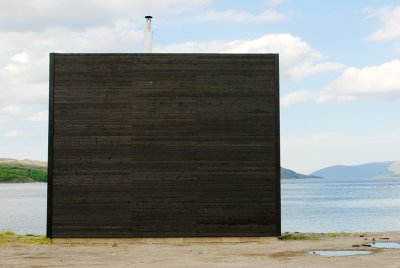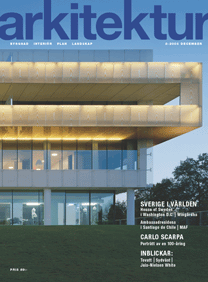More hotel spotting

Hotel + architecture = true sometimes, as shown in Arkitektur’s October issue, 07/2006. Here two more hotels, both Norwegian and noteworthy from a design point of view, spotted during a recent trip to the West.
1. Rintala Rooms, Kirkenes.
In connection with the Barents Art Triennal 2005 architect and professor Sami Rintala together with students from Bergen and Sheffield built a two-room hotel in Kirkenes close to the Norway-Russia border, by the roadside of E6. The place, a simple black box measuring 6 x 5 x 2,5 meters, was built in 8 days and hosts a single room, a double room and a fellow entrance room. From the backside the house appears as a closed wooden block facing the barren Northern nature while the front opens up to the stunning view of Varanger fjord with large, irregularly placed glass screens.
A much-needed overnight recluse for Finnish, Norwegian and Russian sea- and fishermen passing by, as well as for backpackers, according to the architects. A given top candidate to any best-small-hotels-of-the-world-list, according to me.
Reference: Arkitektur.no
2. Farmer’s Home, Oslo.
Norway must be the only country in the world where contemporary fashion designers still create national costume’s collections. Quite nice they are, almost trendy, but as a phenomenon sort of strange. A similar impression is obtained from the Oslo hotel Bondeheimen, which means The Farmer’s Home. The place is located close to parade avenue Karl Johan, run by one of the big American chains, but still owned by Bondeungdomslaget, the Farmers’ Youth Association, a cultural organisation with roots in the early 20:th century. The farmers were always influential in Norway - politically, economically and culturally – resulting in a rich, distinctly local arts and crafts culture. This heritage is now on show at the Bondeheimen in an ambiguous mixture of old and new.
The building is real stuff. Designed in 1911 as Bøndernes Hus, The Farmers’ House, by Carl and Jørgen Berner, respected architects and representative for the search during their time for typically Norwegian forms. The hotel was here from the start, as was the Kaffistova, an old (100 years) and locally invented word for “coffeehouse”, indicating a working class version of the continental café, popular also among artists and writers like Sigrid Undset and Knut Hamsun.
A modernisation of the hotel (127 rooms) started a couple of years ago, still going on. Architects have been Oslo firm Riss, well known and often prized for contemporary, commercially successful restaurant and bar interiors. Their approach connects to the rich farmer’s baroque with obvious, still simplistic means. The colours of the hotel corridors evoke the deep apple greens and lingonberry pinks of Carl Berner’s own family villa in Vindern, designed in 1915. The hotel rooms are functional, strict, with few pieces of furniture, earthly coloured wool in upholstery and – important – a sling of arabesque characteristically stamped to every otherwise geometrically formed, wooden bedstead.
A new Kaffistova was reopened this autumn, styled in the same neo-Norwegian fashion. To complete the ambitions a handicraft shop, Heimen, The Home, houses at street level.
Times apparently are perfect for this Nordic farmer’s look, familiar and unexpected at the same time, both traditionally “honest” and globally seductive. Interestingly the Norwegian farmer’s heritage is talked about as multicultural. In this context multinational would maybe be a more suitable word.



































Inga kommentarer:
Skicka en kommentar